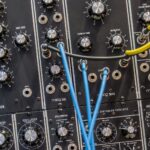Support our educational content for free when you purchase through links on our site. Learn more
Did Kraftwerk Invent Techno? [2024] 🎶

Have you ever wondered who invented techno? Well, if you’re a fan of electronic music, you’ve probably heard of Kraftwerk. This German electronic music band, formed in Düsseldorf in 1970 by Ralf Hütter and Florian Schneider, is often credited with popularizing electronic music and pushing the boundaries of what was possible with synthesizers and drum machines. But did Kraftwerk actually invent techno? Let’s dive into the history and influence of this iconic band to find out!
Quick Answer
No, Kraftwerk did not invent techno. However, they played a significant role in shaping the genre and influencing its development. Their unique blend of electronic elements, pop melodies, and repetitive rhythms laid the foundation for techno music and inspired countless artists in the genre.
Quick Tips and Facts
- Kraftwerk is a German electronic music band formed in 1970.
- They are considered pioneers and innovators of electronic music.
- Kraftwerk’s music combines electronic elements, pop melodies, and repetitive rhythms.
- The band has influenced various music genres, including synth-pop, hip hop, techno, and house music.
- Kraftwerk received the Grammy Lifetime Achievement Award in 2014 and won the Grammy Award for Best Dance/Electronic Album in 2018.
- They were inducted into the Rock & Roll Hall of Fame in 2021.
- Kraftwerk continues to tour as of 2024, showcasing their timeless music to new generations.
Background: Kraftwerk’s Influence on Electronic Music

To understand Kraftwerk’s impact on techno, we need to delve into their history and explore their unique music style. Kraftwerk helped ignite the New Wave and synth-pop movements in the 1970s and 1980s with their innovative use of synthesizers, drum machines, and vocoders. Their music combined electronic sounds with catchy pop melodies, creating a sound that was both futuristic and accessible.
Kraftwerk’s breakthrough album, “Autobahn” (1974), showcased their ability to create immersive electronic landscapes. The title track, a 22-minute epic, became a worldwide hit and introduced audiences to their distinctive sound. The album’s success propelled Kraftwerk into the international spotlight and set the stage for their future experiments with electronic music.
1. The Influence of Kraftwerk on Techno
While Kraftwerk did not invent techno, their influence on the genre cannot be overstated. Techno emerged in the 1980s in Detroit, Michigan, as a fusion of various electronic music styles, including disco, funk, and synth-pop. Artists like Juan Atkins, Derrick May, and Kevin Saunderson, known as the Belleville Three, are often credited with pioneering the genre.
However, Kraftwerk’s impact on techno is undeniable. Their use of synthesizers, drum machines, and repetitive rhythms laid the groundwork for the genre’s signature sound. Tracks like “Trans-Europe Express” (1977) and “Numbers” (1981) showcased Kraftwerk’s ability to create hypnotic, machine-like grooves that would later become hallmarks of techno music.
2. Kraftwerk’s Influence on Other Genres
In addition to techno, Kraftwerk’s influence extends to various other music genres. Their unique blend of electronic and pop elements inspired artists in the realms of synth-pop, hip hop, and house music.
Synth-pop, a genre that emerged in the late 1970s and early 1980s, owes a great debt to Kraftwerk. Bands like Depeche Mode, New Order, and The Human League drew inspiration from Kraftwerk’s use of synthesizers and electronic textures, creating their own brand of catchy, melodic electronic pop.
In hip hop, Kraftwerk’s music became a crucial source for sampling. Artists like Afrika Bambaataa and Grandmaster Flash incorporated Kraftwerk’s beats and melodies into their tracks, helping to shape the sound of early hip hop.
Even in the realm of house music, Kraftwerk’s influence can be felt. House music, which originated in Chicago in the 1980s, drew inspiration from disco, funk, and electronic music. Kraftwerk’s repetitive rhythms and futuristic soundscapes provided a blueprint for the genre’s producers and DJs.
3. Kraftwerk’s Discography and Legacy
Kraftwerk’s discography is a testament to their innovative spirit and enduring influence. In addition to “Autobahn,” the band released seminal albums like “Trans-Europe Express” (1977), “The Man-Machine” (1978), and “Computer World” (1981). These albums showcased Kraftwerk’s ability to create immersive sonic experiences and pushed the boundaries of what was possible with electronic music.
Over the years, Kraftwerk has continued to tour and captivate audiences with their iconic live performances. Their concerts are a multimedia spectacle, combining music, visuals, and technology to create an immersive experience. As of 2024, Kraftwerk continues to inspire new generations of electronic music enthusiasts with their timeless music.
FAQ

Did Kraftwerk start techno?
No, Kraftwerk did not start techno. Techno emerged in Detroit in the 1980s, and artists like Juan Atkins, Derrick May, and Kevin Saunderson are often credited with pioneering the genre. However, Kraftwerk’s influence on techno is undeniable, as their use of synthesizers, drum machines, and repetitive rhythms laid the foundation for the genre’s sound.
Who really invented techno?
The invention of techno is often attributed to the Belleville Three: Juan Atkins, Derrick May, and Kevin Saunderson. These artists, who emerged from the Detroit music scene in the 1980s, combined elements of disco, funk, and electronic music to create the genre. While Kraftwerk’s influence on techno is significant, they are not considered the inventors of the genre.
Who is the father of techno?
The father of techno is often considered to be Juan Atkins, one of the Belleville Three. Atkins, along with Derrick May and Kevin Saunderson, played a pivotal role in shaping the sound of techno and popularizing it in Detroit and beyond. Their innovative use of drum machines, synthesizers, and electronic textures laid the foundation for the genre.
Did techno start in Germany or Detroit?
Techno originated in Detroit, Michigan, in the United States. The genre emerged in the 1980s as a fusion of various electronic music styles, including disco, funk, and synth-pop. While Kraftwerk, a German band, played a significant role in shaping electronic music and influencing techno, the genre itself was born in Detroit.
Conclusion

While Kraftwerk did not invent techno, their influence on the genre cannot be overstated. Their unique blend of electronic elements, pop melodies, and repetitive rhythms laid the foundation for techno music and inspired countless artists in the genre. Kraftwerk’s innovative spirit and timeless music continue to captivate audiences, making them true pioneers of electronic music.
So, the next time you’re enjoying a techno track or exploring the vast world of electronic music, remember the impact that Kraftwerk had on shaping the sounds you love. Their legacy lives on, and their music continues to inspire new generations of artists and music enthusiasts alike.
Recommended Links
- Synth Pop Artists
- Iconic Synth Pop Songs
- Synth Pop Culture Impact
- Synth Pop Concerts and Tours
- 80s Synth Pop
- Kraftwerk: Pioneers of Electronic Music 2024 🎶


